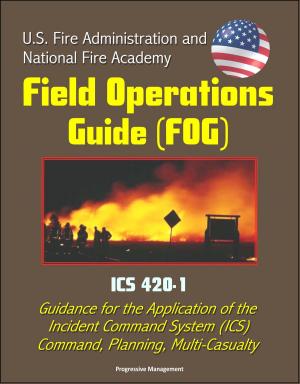Challengers from the Sidelines: Understanding America's Violent Far-Right - Aryan Nation, Timothy McVeigh, Oklahoma City Bombing, KKK, Racism, White Supremacy, Neo-Nazi, Skinheads, Christian Identity
Nonfiction, Social & Cultural Studies, Political Science| Author: | Progressive Management | ISBN: | 9781301318001 |
| Publisher: | Progressive Management | Publication: | January 18, 2013 |
| Imprint: | Smashwords Edition | Language: | English |
| Author: | Progressive Management |
| ISBN: | 9781301318001 |
| Publisher: | Progressive Management |
| Publication: | January 18, 2013 |
| Imprint: | Smashwords Edition |
| Language: | English |
This contemporary report, issued in early 2013, provides a thorough analysis of far-right terrorism and violence. Subjects covered include: Aryan nation, White Aryan resistance, Timothy McVeigh, Oklahoma City bombing, Ku Klux Klan (KKK), racism, white supremacy groups, anti-Semitism, Neo-Nazi, David Duke, skinheads, fascism, the Christian identity movement, anti-abortion violence, the American Nazi Party, militias, Ruby Ridge, the Montana Militia, and the Army of God.
The introduction states:
In the last few years, and especially since 2007, there has been a dramatic rise in the number of attacks and violent plots originating from individuals and groups who self-identify with the far-right of American politics. These incidents cause many to wonder whether these are isolated attacks, an increasing trend, part of increasing societal violence, or attributable to some other condition. To date, however, there has been limited systematic documentation and analysis of incidents of American domestic violence. This study provides a conceptual foundation for understanding different far-right groups and then presents the empirical analysis of violent incidents to identify those perpetrating attacks and their associated trends. Through a comprehensive look at the data, this study addresses three core questions: (1) What are the main current characteristics of the violence produced by the far right? (2) What type of far-right groups are more prone than others to engage in violence? How are characteristics of particular far-right groups correlated with their tendency to engage in violence? (3) What are the social and political factors associated with the level of far-right violence? Are there political or social conditions that foster or discourage violence? It is important to note that this study concentrates on those individuals and groups who have actually perpetuated violence and is not a comprehensive analysis of the political causes with which some far-right extremists identify. While the ability to hold and appropriately articulate diverse political views is an American strength, extremists committing acts of violence in the name of those causes undermine the freedoms that they purport to espouse.
There are three major ideological movements within the American violent far right: a racist/white supremacy movement, an anti-federalist movement and a fundamentalist movement. The ideological characteristics of the different movements affect their operations in terms of tactics used, targets selected, and operations conducted. The racist movement is comprised of white supremacy groups such as the KKK, neo-Nazi groups such as the National Alliance and Skinheads groups such as the Hammerskin Nation. The groups comprising this movement are interested in preserving or restoring what they perceive as the appropriate and natural racial and cultural hierarchy, by enforcing social and political control over non-Aryans/nonwhites such as African Americans, Jews, and various immigrant communities. Therefore, their ideological foundations are based mainly on ideas of racism, segregation, xenophobia, and nativism (rejection of foreign norms and practices). In line with the movement's ideology, the great majority of attacks perpetrated by the racist groups are aimed against individuals or groups affiliated with a specific minority ethnic group, or identifiable facilities (mosques, synagogues, or schools affiliated with minority communities). However, while the KKK extremists are heavily involved in acts of vandalism, extremists from Skinheads and Neo-Nazi groups are more likely to engage in attacks against people, including mass casualty attacks.
This contemporary report, issued in early 2013, provides a thorough analysis of far-right terrorism and violence. Subjects covered include: Aryan nation, White Aryan resistance, Timothy McVeigh, Oklahoma City bombing, Ku Klux Klan (KKK), racism, white supremacy groups, anti-Semitism, Neo-Nazi, David Duke, skinheads, fascism, the Christian identity movement, anti-abortion violence, the American Nazi Party, militias, Ruby Ridge, the Montana Militia, and the Army of God.
The introduction states:
In the last few years, and especially since 2007, there has been a dramatic rise in the number of attacks and violent plots originating from individuals and groups who self-identify with the far-right of American politics. These incidents cause many to wonder whether these are isolated attacks, an increasing trend, part of increasing societal violence, or attributable to some other condition. To date, however, there has been limited systematic documentation and analysis of incidents of American domestic violence. This study provides a conceptual foundation for understanding different far-right groups and then presents the empirical analysis of violent incidents to identify those perpetrating attacks and their associated trends. Through a comprehensive look at the data, this study addresses three core questions: (1) What are the main current characteristics of the violence produced by the far right? (2) What type of far-right groups are more prone than others to engage in violence? How are characteristics of particular far-right groups correlated with their tendency to engage in violence? (3) What are the social and political factors associated with the level of far-right violence? Are there political or social conditions that foster or discourage violence? It is important to note that this study concentrates on those individuals and groups who have actually perpetuated violence and is not a comprehensive analysis of the political causes with which some far-right extremists identify. While the ability to hold and appropriately articulate diverse political views is an American strength, extremists committing acts of violence in the name of those causes undermine the freedoms that they purport to espouse.
There are three major ideological movements within the American violent far right: a racist/white supremacy movement, an anti-federalist movement and a fundamentalist movement. The ideological characteristics of the different movements affect their operations in terms of tactics used, targets selected, and operations conducted. The racist movement is comprised of white supremacy groups such as the KKK, neo-Nazi groups such as the National Alliance and Skinheads groups such as the Hammerskin Nation. The groups comprising this movement are interested in preserving or restoring what they perceive as the appropriate and natural racial and cultural hierarchy, by enforcing social and political control over non-Aryans/nonwhites such as African Americans, Jews, and various immigrant communities. Therefore, their ideological foundations are based mainly on ideas of racism, segregation, xenophobia, and nativism (rejection of foreign norms and practices). In line with the movement's ideology, the great majority of attacks perpetrated by the racist groups are aimed against individuals or groups affiliated with a specific minority ethnic group, or identifiable facilities (mosques, synagogues, or schools affiliated with minority communities). However, while the KKK extremists are heavily involved in acts of vandalism, extremists from Skinheads and Neo-Nazi groups are more likely to engage in attacks against people, including mass casualty attacks.















